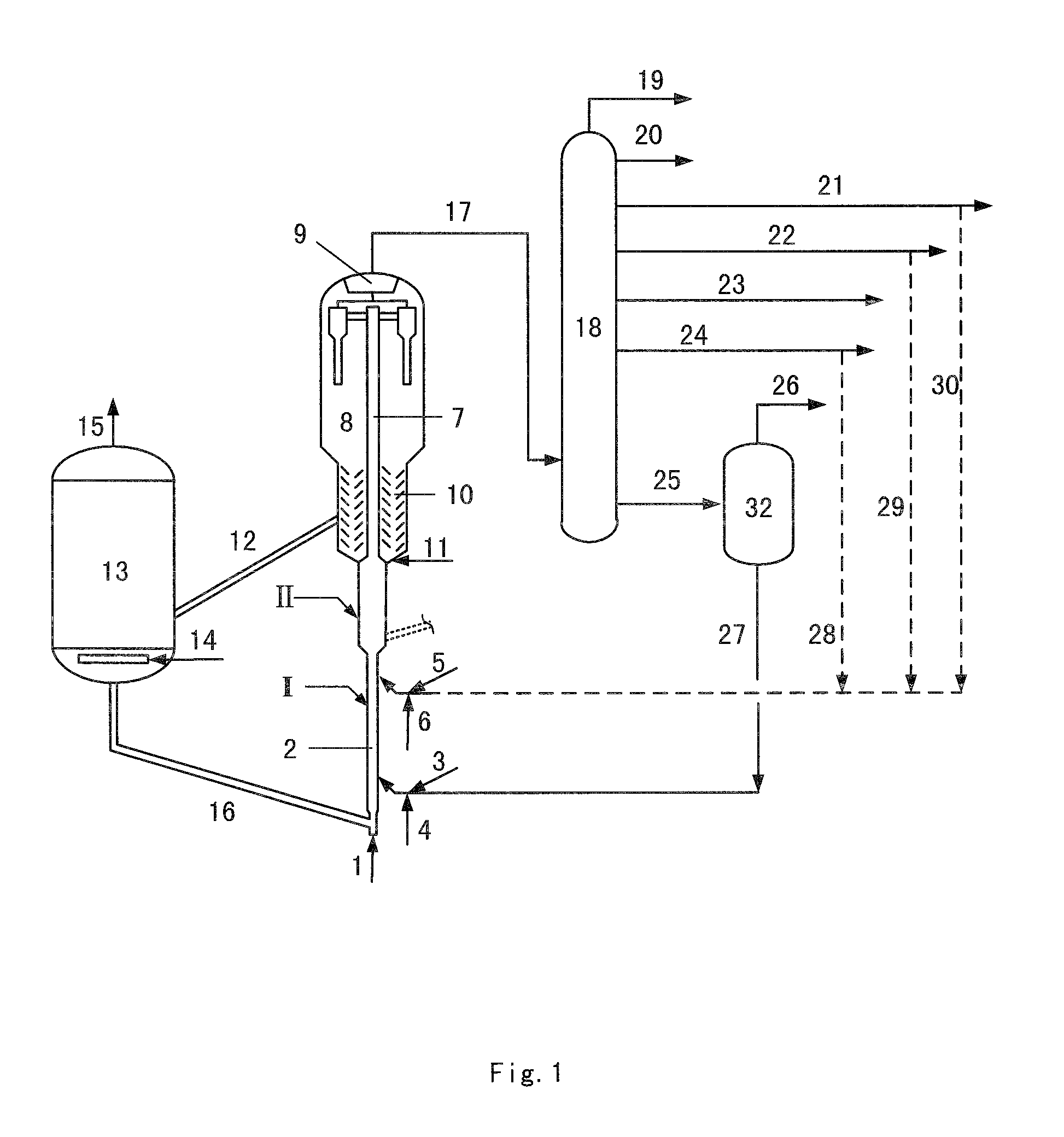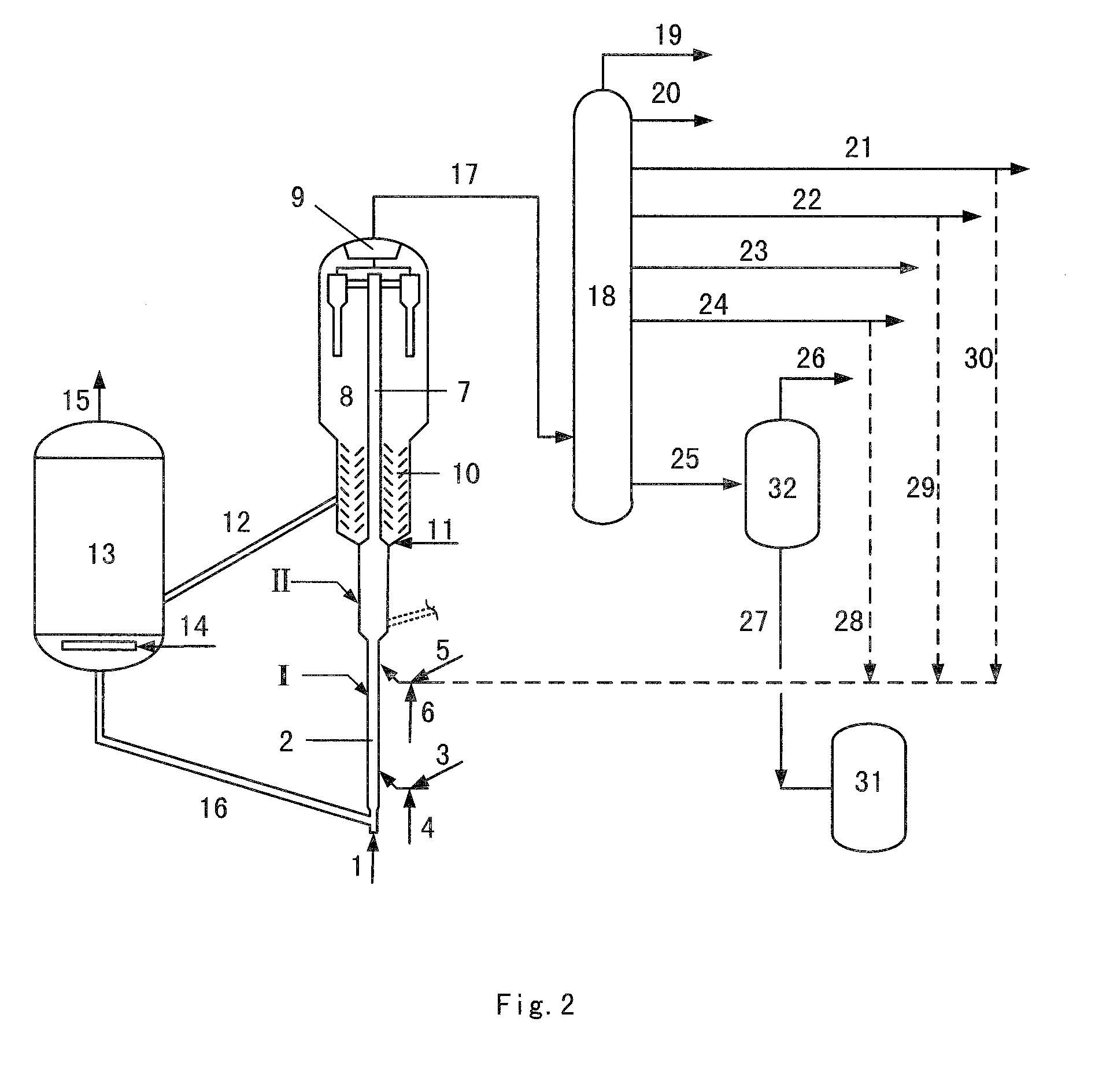Process for converting inferior feedstock to high quality fuel oil
a technology of hydrocarbon oil and feedstock, which is applied in the field of catalytic conversion of hydrocarbon oils, can solve the problems of increasing the price difference between inferior crude oil and high quality crude oil, poor crude oil quality, and low yield of liquid products, and achieves enhanced propylene yield, high quality fuel, and enhanced propylene yield
- Summary
- Abstract
- Description
- Claims
- Application Information
AI Technical Summary
Benefits of technology
Problems solved by technology
Method used
Image
Examples
example 1
[0068]In the experiment of the present example, Vacuum residue oil A was directly used as the feedstock of catalytic cracking and the experiment was conducted in a pilot riser reactor plant. Inferior feedstock A was injected into the lower part of the reaction zone I, wherein the catalytic cracking reaction was conducted by contacting catalyst GZ-1 with the feedstock. In the lower part of reactor zone I, the reaction temperature was 600° C., the WHSV was 100 h−1, the C / O was 6, and the weight ratio of steam / the feedstock was 0.05. In reactor zone II, reacted vapors from reactor zone I, the recycled propane, C4 hydrocarbons and diesel are mixed and subjected to cracking reactions, wherein the reaction temperature was 500° C., the WHSV was 30 h−1, and the weight ratio of steam / the feedstock was 0.05. Reaction product vapors and the spent catalyst were separated in the disengager, and then the products were separated, wherein dry gas, LPG (include propylene, propane and C4 hydrocarbons...
example 2
[0072]The experiment of the present example was carried out according to the scheme shown in FIG. 2. Feedstock C was directly used as the feedstock of catalytic cracking and the experiment was conducted in a pilot riser reactor plant. Inferior feedstock C was injected into the lower part of the reaction zone I, wherein the catalytic cracking reaction was conducted by contacting catalyst GZ-1 with the feedstock. In the lower part of reactor zone I, the reaction temperature was 600° C., the WHSV was 100 h−1, the C / O was 6, and the weight ratio of steam / the feedstock was 0.05. In reactor zone II, reacted vapors from reactor zone I and quench medium(cooled regenerated catalyst) are mixed and subjected to cracking reactions, wherein the reaction temperature was 500° C., the WHSV was 30 h−1, and the weight ratio of steam / the feedstock was 0.05. Reaction product vapors and the spent catalyst were separated in the disengager, and then the products were separated, wherein dry gas, LPG, gasol...
example 3
[0076]The experiment of the present example was carried out according to the scheme shown in FIG. 2. High acid value feedstock E was directly used as the feedstock of catalytic cracking and the experiment was conducted in a pilot riser reactor plant. Inferior feedstock E was injected into the lower part of reaction zone I, wherein the catalytic cracking reaction was conducted by contacting catalyst GZ-1 with the feedstock. In the lower part of reactor zone I, the reaction temperature was 600° C., the WHSV was 100 h−1, the C / O was 6, and the weight ratio of steam / the feedstock was 0.05. In reactor zone II, reacted vapors from reactor zone I are carried out cracking reactions, wherein the reaction temperature was 500° C., the WHSV was 30 h−1, and the weight ratio of steam / the feedstock was 0.05. Reaction product vapors and the spent catalyst were separated in the disengager, and then the products were separated, wherein dry gas, LPG, gasoline, diesel and FGO (the cutting temperature i...
PUM
| Property | Measurement | Unit |
|---|---|---|
| density | aaaaa | aaaaa |
| density | aaaaa | aaaaa |
| pressure | aaaaa | aaaaa |
Abstract
Description
Claims
Application Information
 Login to View More
Login to View More - R&D
- Intellectual Property
- Life Sciences
- Materials
- Tech Scout
- Unparalleled Data Quality
- Higher Quality Content
- 60% Fewer Hallucinations
Browse by: Latest US Patents, China's latest patents, Technical Efficacy Thesaurus, Application Domain, Technology Topic, Popular Technical Reports.
© 2025 PatSnap. All rights reserved.Legal|Privacy policy|Modern Slavery Act Transparency Statement|Sitemap|About US| Contact US: help@patsnap.com



